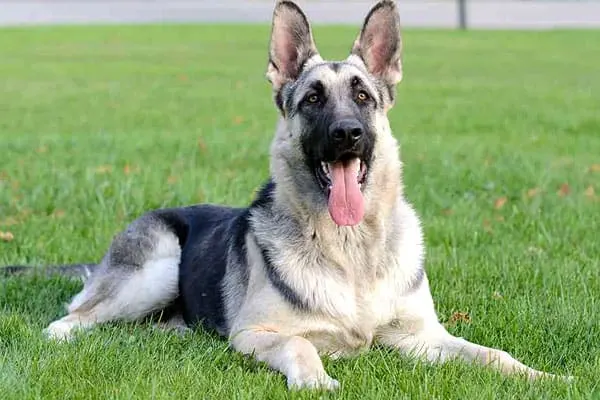The Unusual Silver German Shepherd: What Should You Know About It?
Silver-colored German Shepherd dogs are a rare breed. The silver does not refer to a shimmering coat quality but any dog with an off-tan coloration.
Their silver can be in the range of cream and off-white. Scientists have explained that this trait originates from red or tan hairs modifier.
Genes or alleles decide the coat pattern and color of all dogs. Allele refers to a variant form of a gene. There are two copies for every set of genes, and they may be identical or different.
When they are different, one copy may dominate the other and appear as a physical characteristic.
The additional copy becomes the recessive trait and does not appear as a physical characteristic. Recessive traits can physically appear in later generations.

Silver German Shepherds are extremely rare because they acquire the recessive gene from both parents.
There are multiple reasons for a silver coat in a German Shepherd. In the l locus, a switch of a gene determines the saturation and intensity of red and yellow in canines.
Upon activation failure or partial activation, the dog gains a lighter color.
The dilution gene is a recessive trait and is also responsible for affecting black and red hair.
A new gene called the KIT gene has been recently discovered that imparts cream or pale beige color to the tan or red areas of the coat.
The E locus is a dominant gene responsible for the black facial mask of German Shepherds.
The Agouti gene or A locus is an essential factor for the unusual silver color of the silver German Shepherd.
The A locus has four major alleles, namely- Ay (Dominant Sable), aw (Wild Sable), at (Black and tan or tan-pointed gene), and a (Recessive Black).
German shepherds can express any of them, and three of them allow silver expression.
One may register a silver German Shepherd with the AKC (American Kennel Club).
However, silver is penalized by the judges as a fault because it is a dilute color, and most jury panels prefer rich and bright colors, as per the breed standard.
Black and silver shepherds can grow 22 to 26 inches tall and weigh approximately 100 pounds. Silver shepherds have distinctive heads, domed foreheads, upright ears and are extremely rare.
They are usually aloof among strangers and use their discretion and degree of socialization to detect danger or threat. They are intelligent, bold, and have guarding instincts.
Silver German Shepherds may experience multiple health issues like epilepsy, hip dysplasia, pannus, etc., that are common to all German Shepherds.
They thrive on exercise and need a minimum of two hours of physical activity every day.
Silver German Shepherds may cost more than other varieties because they are rare. They generally bond with one person but extend their protection to all family members.
They are friendly with children but must not be left unattended because of their large size and strength.
They are loyal and affectionate and have a life span of ten to thirteen years.
What is a silver German Shepherd and how do you obtain the color?
A silver German Shepherd is not always literally a gray dog that shimmers. Silver refers to any Shepherd with off-tan coloration.
In German Shepherds, silver can range from a cream color to an off-white.
Very light-colored fur appears silver or gray next to the contrasting black hairs in a sable dog or against the backdrop of a black blanket or saddle.
Scientists believe they can explain the unusual color as the action of a modifier on red or tan hairs.
What is responsible for coat colors in the German Shepherd?
Genes or alleles are responsible for coat colors and patterns in all dogs. Experts have narrowed color genes in dogs to a limited number, although they continue to make new discoveries.
German Shepherds are relatively easy because they are even more limited than other breeds.
Alleles for color receive influence from their different locations or loci along the dog’s chromosomes. Scientists assign a name or set of letters to each locus.
Every set of genes has two copies, which can be identical or different. If the two copies are different, one usually dominates the other.
The dominant copy shows up as a physical characteristic while the other is recessive and does not appear.
Since each parent randomly passes one of their two gene copies to each puppy, recessive traits can make an appearance in later generations.
An example is a black and tan gene that is dominant over solid black in German Shepherds.
Two black and tan parents could carry a copy of the solid black gene, but they only express the dominant pattern. Their genes would look like so: “at/ab” x “at/ab.”
The black and tan color express instead of the black color that is also genetically present. If you enter that into a Mendelian Punnet Square, the results of four puppies would like like this:
| “at” tan-pointed | “ab” solid black | |
|---|---|---|
| “at” tan-pointed | “at/ab” | “at/ab” |
| “ab” solid black | “at/ab” | “ab/ab” |
The chart translates into three black and tan puppies and one solid black pup. Punnett Square becomes relevant as you see how the silver color arises in Shepherds.
Note how in order for a recessive gene to show up, two copies must be present.

Alleles not believed present in the German Shepherd.
Figuring out why German Shepherds are silver becomes easier when we can eliminate a few causative factors from the start.
- “H” locus – Harlequin you see in Great Danes
- “M” locus – Has gene responsible for merle. Merle is a marbling of black and white, often looking blue in Heelers, Dachshunds, and Aussies. Merle does not occur in purebred German Shepherds
- “K” locus – We believe German Shepherds are always recessive “ky/ky,” meaning they are not dominant black like French Bulldogs and Labradors. A “ky/ky” genotype allows the German Shepherd to express the agouti color group discussed below. “KBr” is brindle and breeders have eliminated it from the German Shepherd gene pool.
- “S” locus – The white spotting and piebald gene does not cause the piebald in panda German Shepherds nor the solid white German Shepherd.
Alleles where silver can occur in German Shepherds
“I” locus
Geneticists have not yet confirmed but believe there is a “switch” that determines the intensity of reds and yellows in canids.
If the gene fails to turn on or only has a partial effect, dogs will be very light or have a washed-out appearance.
The recessive intensity suppression gene is similar to the dilution gene that acts on black pigment. The lighter a Shepherd’s tan points are, the more silvery she looks.
“D” locus
Silver German Shepherds are not blue dogs. The dilution gene affects black hair or eumelanin. It also affects red hair but makes them muddy rather than pale.
Diluted dogs are “d/d” while normal dogs are “D/D” or “D/d.” The Dilution gene is recessive. You can refer to a blue German Shepherd as a steel blue or mouse gray.
“KIT” gene
A recently-discovered KIT gene is responsible for the piebald German Shepherd. Panda German Shepherds can be silver, albeit rare. Silver will show up as cream or pale beige where the tan or red would be.
“E” locus
The “E” locus is mostly relevant in German Shepherds as the dominant black facial mask. Silver German Shepherds still usually have a black mask and are “Em/e,” “Em/Em,” or “Em/E.”
“E/E” and “E/e” dogs do not have a mask but have the dominant gene that allows black expression in the coat.
Recessive “e/e” dogs cannot produce eumelanin in their fur and are white, yellow, or red depending on the breed.
Dutch Shepherds that are “e/e” are yellow to tan. German Shepherds with the “e/e” gene are usually white.
Scientists think that as for silver dogs, a separate gene or modifier suppresses red pigment in White Shepherds.
White dogs with reddish fur around their ears and across their backs seem to support the action of another gene.
“B” locus
Liver Shepherds do not have anything to do with silver coloration. “B/B,” and “B/b” dogs are normal while “b/b” Shepherds cannot produce black pigmentation anywhere.
These dogs are chocolate with no effect on tan markings.

A major player in silver German Shepherds is the agouti gene or “A” locus.
Agouti is a somewhat confusing word because it refers to a color and also a locus. Animal Genetics refers to the “A” locus which encompasses four major alleles.
German Shepherds can express any of the four alleles, not a common trait among dogs. Three of the genes allow the expression of silver.
“Ay” – Dominant sable; Dogs will be fawn or red sable.
Sable takes various forms depending on the breed. If a German Shepherd is “Ay,” she is usually a shaded sable were black and red mesh haphazardly together.
Collies are an example of white Irish spotting and sable where breeders have selected for few or no black bands in the hair. In a German Shepherd, cream in place of the red banding gives you a silver dog.
“aw” – Wild sable – Most sable German Shepherds are wild sable, colored similarly to gray wolves.
They often have less red and more grays and black than shaded sables, although it can be difficult to differentiate without a blood test.
Wild sables can be silver. Patterned sables have the semblance of an unorganized saddle or blanket and could demonstrate incomplete dominance of the wild sable gene over the tan-pointed gene.
“at” – Black and tan or tan-pointed gene – Most common expression of silver, usually pale cream with a black saddle or blanket.
“a” – Recessive black – Solid black dog.
Silver German Shepherds have a base color of black and tan or wild sable. The intensity gene likely shows incomplete dominance.
Dogs with two dominant intensity genes “I/I” would show more vivid reds and tans than one whose code was “I/I,” for instance. Very light or silver dogs would be “i/i.”
Experts do not yet completely understand the relationships of genes that affect color intensity.
The theory is that two bright-colored show line dogs would not produce silver German Shepherd puppies, but offspring from their litters potentially could.
An example is if you have two black and red European show dogs, and the male is not quite as rich in color as the female.
Imagine the female genotype is across the top of the chart and the male’s down the left side.
| “at/I” | “at/I” | |
|---|---|---|
| “at/I” | “at/at,I/I” | “at/at,I/I” |
| “at/i” | “at/at,I/i” | “at/at,I/i” |
Two puppies would be brightly-colored black and tan dogs, and the other half might be a little less vivid. In the example, two would-be carriers of silver.
If a breeder combined a carrier with another dog of a similar genotype, about 25% of the resulting puppies could be black and silver.
| “at/I” | “at/i” | |
|---|---|---|
| “at/I” | “at/at,I/I” | “at/at,I/i” |
| “at/i” | “at/at,I/i” | “at/at,i/i” |
You can see how one out of four German Shepherd puppies is potentially silver with two carriers.
The upper scenario illustrates how color intensity can eventually fade in lines of German Shepherds and not because of breeding to White Shepherds.
However, white German Shepherds can also produce silver Shepherds.
White Shepherds have coding for normal colors but do not express because of the “e/e” influence.
The genetic sequence for a white German Shepherd who could pass silver to her German Shepherd puppies would be as follows: “aw/at, i/I,e/e.”
The example is a German Shepherd with a wild sable genotype but a white phenotype or appearance. You then match her with a black and tan dog with normal color intensity.
| “aw/i/e” | “at/i/e” | |
|---|---|---|
| “at/I/Em” | “aw/at,I/i,Em/e” | “at/at,I/i,Em/e” |
| “at/i/Em” | “aw/at,i/i,Em/e” | “at/at,i/i,Em/e” |
You could potentially get a wild sable silver German Shepherd and a black and silver dog.

How does silver relate to black and tan?
Black and tan German Shepherds come in three varieties. Geneticists have determined they are genetically the same and label them all “at.”
- Tan with black in a distinct saddle pattern – A saddle can be minimal or extended.
- Tan with a black extended blanket
- Black and tan bicolor – Tan markings are minimal at points of eyes, at the shoulders, and minimal streaks on the toes. Some dogs have markings more like Rottweilers, with tan or silver on the front of the chest and extending up the insides of the hind legs. Genetic testing may distinguish Shepherds with extended blankets versus bicolor dogs. Blanketed dogs have the RALY gene present.
Experts discovered a separate gene, one they call RALY, that is responsible for the saddle pattern in black and tan dogs like the German Shepherd and Lakeland Terrier.
Creeping tan affects silver the same as it would brown or red.
Some tan-pointed dogs end up with little brown or silver creeping and thus have extended blankets. Others have a very small saddle.
The “E” locus may also affect the amount of black masking throughout the body.
Since many of the coat variations in German Shepherds act on the dark pigment or eumelanin, you will describe dilutions and other modifications just as you would a black and tan German Shepherd.
Therefore, blue dogs can be blue and tan, solid blue, and blue bicolor.
Sable dogs can also be blue, where dilution affects the black banding. The liver acts exactly the same as blue, whereby chocolate brown or lighter browns replace areas of black.
Silver is a modification of reds and tans or phaeomelanin pigmentation, so dogs are black and silver. Silver bi-colors are predominantly black with minimal points of silver.
Silver and black dogs can have extended saddles and blankets, just like their tan counterparts.
Just as there are not fawn German Shepherds, silver does not usually present as a solid color. Solid gray dogs have a separate gene at work and are blue, not silver.
A rare individual may show minimal black markings and may appear solid gray.
If you look closely at these dogs, you will see the faint hint of a saddle or black banding or ticking of a sable or agouti German Shepherd.
You can distinguish cream and silver versus blue or Isabella dogs by looking at their eyes. Silver dogs have no disruption of eumelanin and will have dark eyes.
Blue and Isabella Shepherds, on the other hand, have light-colored eyes.
Can you register and show a silver German Shepherd?
You register silver dogs with the AKC as black and silver dogs. They have full access to all conformation exhibitions and other shows that the American Kennel Club offers.
However, silver is a dilute color, and judges penalize it as a fault.
Even without penalties, judges consistently show a preference for bright and rich colors encouraged by the breed standard.
Silver is an accepted color variation of the German Shepherd Dog. Silver can infiltrate sable, but the AKC simply classifies those dogs as sable.
They do not distinguish the various shades of sable or the presence of brown versus pale tans or creams.
A fancier may use the term silver sable. But throughout the registries and show circuits, silver mostly refers to the black and silver dog.
However, the AKC does differentiate black and silver from black and cream, which may be difficult for most people to do.
In the end, black and silver are quite different from black and tan, but its distinction from black and cream is much more subjective.
Black and silver dogs may more closely approach white with less of the reddish or yellowish hue that cream-colored Shepherds have.

How do silver German Shepherds differ from the breed standard?
Silver German Shepherds stay true to the breed standard, whether UKC, SV, or AKC.
Black and silver Shepherds are 22 to 26 inches tall and weigh 50 to 100 pounds.
In the show ring, you should be able to differentiate a Shepherd’s gender based on differences in bone substance and muscular development. Females should be somewhat finer in their overall impression.
Silver Shepherds, like all Alsatians, have a distinctive head with upright ears and a domed forehead. White Shepherds often have much less of a stop.
Otherwise, all colors of Shepherds have a moderately long body length to height ratio, a short to medium dense double coat, and a long, plush tail.
Silver Shepherds are usually aloof with strangers, using inherent discretion and degree of socialization to detect threats. They should be polite, only attacking when they have exhausted all other means of intimidation.
A silver German Shepherd is rare. Silver shepherd work in the police force, search and rescue, and the military, where the emphasis on silver German Shepherd appearance is not a factor.
As family dogs, German Shepherds are loyal and affectionate. They have a tendency to bond with one person, although they extend their protection to the entire household.
Persistent work will help German Shepherds bond with multiple family members and handlers.
Like any German Shepherd, silver Shepherds are intelligent and bold with excellent guarding instincts.
They require a trainer who can carry out commands and positive reinforcement consistently and confidently.
German Shepherds may challenge an individual who shows uncertainty or otherwise fails to gain their respect.
Silver German Shepherds have several health issues, according to MASGR.org. They do not have any more health challenges than Shepherds of other colors.
- Epilepsy – Unexplained seizures
- Low thyroid production
- Elbow dysplasia
- Hip Dysplasia
- Stomach bloat and torsion
- Pannus – Inflammation of the cornea of the eye
- Degenerative myelopathy – Progressive neurologic disorder
- Panosteitis – Bone inflammation of growing German Shepherd puppies
- Von Willebrand’s – Clotting disorder
Silver Shepherds get along with children and dogs within the household but can have issues with some individuals, both canine and child, outside the family.
Shepherds are protective of children they know but should not be alone with any kids because of their size and strength.
Exercise is one of the most important basic needs you can provide your silver German Shepherd. German Shepherds require as much as two hours of exercise every day.
You must provide mental and physical challenges through strenuous activities, training, and problem-solving exercises. Socialization is a vital part of the exercise process.
Example 1
This video illustrates a dog who is pale tan with an extended blanket. Judging by the black color on the head, this dog probably has a heavy influence of masking at the E” locus.
Nevertheless, he demonstrates how a black and silver shepherd does not necessarily look gray.
Example 2
In this video, the dog is a more dramatic black and silver. Many silver German Shepherds show remarkable contrast between a cream-colored base and black mask and body pattern.
You will frequently notice unique facial patterns on the heads of black and silver German Shepherds as opposed to standard black and tan Shepherds.
Frequently Asked Questions
Are silver German shepherds rare?
The reason that you so rarely see many silver German shepherds around, is because they are quite rare…
The unique silver colored coat is the result of receiving two recessive genes for their silver coat, one from each parent.
This means that both of the silver German shepherd’s parents would have to be carriers of the gene…
But this doesn’t mean that one or both of the parents would necessarily have to have a silver coat as well, as this can skip several generations.
This can make it very difficult for breeders to get a German shepherd with a silver coat, because you never really know when a German shepherd is going to be silver, because it comes from a recessive gene that doesn’t always show itself in the parents.
Even if both the parents were carriers of the recessive gene, there’s still only a one in four chance that the puppy will have a silver coat.
How much does a silver German shepherd cost?
The average cost of a silver German shepherd can range from as little as five hundred dollars to as much as one thousand five hundred or more.
Because silver German shepherds are relatively rare, this could prompt the breeder to push up the price, and you will often find that you have to pay more money for a silver German shepherd than you would for one of the more common breeds.
There are several factors that can affect the cost of the dog, including whether its parents were also silver German shepherds, and the age of the dog when you buy it.
Adopting a silver German shepherd is often a far more affordable way of taking one in as a pet, rather than buying one directly from a breeder.






























